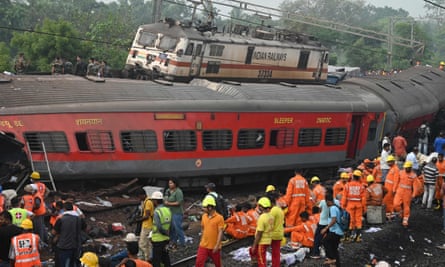India train crash: at least 280 killed and 900 injured in Odisha state
At least 280 people have been killed and about 900 injured after two passenger trains collided in the eastern Indian state of Odisha – the country’s deadliest rail disaster in almost 20 years.

The Coromandel Express, which runs from Kolkata in West Bengal to Chennai in Tamil Nadu, was going about 80mph (130km/h) when it collided with a stationary freight train at about 7pm on Friday, causing it to derail.
Carriages from the freight train then hit two coaches from the Howrah Superfast Express train, which was travelling in the opposite direction, according to South Eastern Railway, resulting in the deadly pile-up.
Rajesh Kumar, the senior deputy commercial manager of South Eastern Railway, said the Coromandel Express had changed tracks, which led to the incident, and that the reason would be investigated.
The death toll was expected to increase as more bodies were recovered from the wreckage and overturned carriages, said the state chief secretary, Pradeep Jena. More than 200 ambulances were called to the scene in Odisha’s Balasore district and 100 additional doctors, on top of 80 already there, had been mobilised, he added. About 850 people had been taken to hospital.
“The rescue work is continuing on a war footing,” Jena said. “Additional medical equipment and drugs at hospitals where victims are being treated are also being taken care of.”
India’s prime minister, Narendra Modi, said “all possible assistance” was being given to those affected. He chaired a high-level meeting about the crash on Saturday and is scheduled to visit the incident site later today.
Rescue workers and military personnel gather around damaged carriages at the accident site on Saturday. Photograph: Dibyangshu Sarkar/AFP/Getty ImagesRescue teams were mobilised from Odisha’s capital of Bhubaneswar and Kolkata in West Bengal, said the federal minister for railways, Ashwini Vaishnaw, as well as from the National Disaster Response Force, state government teams and the air force. Hundreds of fire department personnel, police officers and sniffer dogs were also involved.
Images from the scene showed hundreds of rescuers climbing up the mangled wreckage of the trains as they worked frantically overnight to find survivors.
Speaking on Saturday morning, after rescue efforts had gone on for almost 12 hours, Sudhanshu Sarangi, the director general of the fire department in Odisha, said: “We’re trying to locate bodies that might still be trapped under the mangled compartments. The operations will continue for a few more hours.”
Visiting the incident site on Saturday morning, the railway minister, Ashwini Vaishnaw, promised a “high-level” investigation into what had caused the crash. “A detailed high-level probe would be conducted and the railway safety commissioner would also do an independent inquiry. Right now, the focus is on rescue and relief operations,” he said.
At Howrah and Chennai railway stations, desperate relatives gathered hoping for news about survivors. One survivor told local television news he had been sleeping when the crash happened and woke to find himself trapped under about a dozen passengers before crawling out from the carriage with only injuries to his neck and arm.
“When I got out of the train, I saw limbs scattered all around, a leg here, a hand there. Someone’s face was disfigured,” he said.
Another witness told Reuters all he could see was “blood, broken limbs and people dying around me”.
At Bhadrak district hospital, ambulances brought in casualties, with the bloodied and shocked survivors receiving treatment in crowded wards. Hundreds of young people lined up outside a government hospital in the city of Soro in Odisha to donate blood.
Despite government efforts to improve safety and update ageing infrastructure, several hundred accidents occur every year on India’s railways. With 40,000 miles (64,000km) of track carrying 13 million passengers on 14,000 trains daily, they comprise the world’s largest train network under one management.
Two trains collided near Delhi in August 1995, killing 358 people in the worst train accident in India’s history. Most train accidents are blamed on human error or outdated signalling equipment.






































































